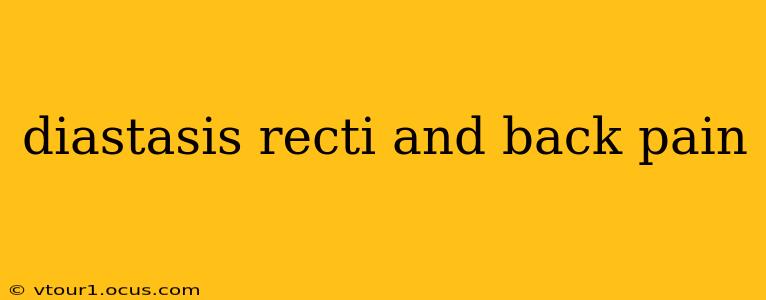Diastasis recti, the separation of the abdominal muscles, is a common postpartum condition affecting many new mothers. While often associated with abdominal discomfort and a bulging belly, it can also contribute to back pain. This article explores the link between diastasis recti and back pain, offering insights into causes, symptoms, and effective management strategies.
What is Diastasis Recti?
Diastasis recti occurs when the rectus abdominis muscles (the "six-pack" muscles) separate at the linea alba, the connective tissue that runs down the middle of the abdomen. This separation can range from a slight widening to a significant gap. While pregnancy and childbirth are primary culprits, diastasis recti can also occur in individuals who are significantly overweight or have undergone abdominal surgery. The widening of this connective tissue weakens the core, leading to a cascade of potential problems, including back pain.
How Does Diastasis Recti Cause Back Pain?
The connection between diastasis recti and back pain is multifaceted. A weakened core, resulting from the separation of the abdominal muscles, impacts the body's natural posture and stability. This instability forces compensatory mechanisms, often leading to:
- Increased Spinal Load: The back muscles have to work harder to compensate for the weakened abdominal support, leading to increased strain and potential injury. This increased load can manifest as lower back pain, but also pain in the upper back and neck.
- Altered Pelvic Alignment: A weakened core can disrupt the optimal alignment of the pelvis, affecting the biomechanics of the spine and increasing the risk of lower back pain.
- Muscle Imbalances: The body adapts to the instability caused by diastasis recti, leading to muscle imbalances throughout the core and back. Tight muscles in the hips and lower back often accompany this imbalance, exacerbating back pain.
- Poor Posture: Without the support of strong abdominal muscles, posture can suffer, contributing to increased spinal stress and back pain.
What are the Symptoms of Diastasis Recti and Back Pain?
Identifying diastasis recti can be straightforward. Lie on your back, knees bent, and gently lift your head off the floor. Feel along the midline of your abdomen. A noticeable bulge or separation indicates diastasis recti. The severity of the separation varies.
Back pain associated with diastasis recti might manifest as:
- Lower back pain: This is the most common complaint, often radiating to the hips or buttocks.
- Upper back or neck pain: Due to compensatory posture adjustments.
- Pain that worsens with activity: Especially activities involving lifting, bending, or twisting.
- Persistent aching: Rather than sharp, stabbing pain.
Can Diastasis Recti Be Treated?
Fortunately, diastasis recti is often manageable with a combination of targeted exercises and lifestyle modifications. While surgical intervention is rarely necessary, consulting a physical therapist specializing in postpartum rehabilitation is crucial. A tailored exercise program should focus on:
- Deep core engagement: Strengthening the transverse abdominis, a deep abdominal muscle that plays a vital role in core stability.
- Pelvic floor exercises: Strengthening the pelvic floor muscles is essential for overall core stability.
- Postural correction: Improving posture reduces strain on the spine.
- Proper lifting techniques: Avoiding strain on the back during daily activities.
Does Diastasis Recti Always Cause Back Pain?
No, diastasis recti doesn't always cause back pain. Many individuals experience diastasis recti with minimal or no back pain. The presence of back pain often depends on factors such as the severity of the separation, pre-existing back conditions, and individual body mechanics.
How Can I Prevent Diastasis Recti and Associated Back Pain?
Prevention is always better than cure. Pregnant women can reduce their risk of diastasis recti by:
- Maintaining good core strength before and during pregnancy: Engaging in regular exercise that focuses on core stability.
- Practicing good posture: Maintaining an upright posture reduces strain on the abdominal muscles.
- Avoiding strenuous activities that overstretch the abdominal muscles: Listen to your body and adjust activities accordingly.
- Seeking professional guidance: Consulting a physical therapist or healthcare professional specializing in pregnancy and postpartum care.
When Should I See a Doctor?
If you experience persistent back pain, especially if it's severe, doesn't improve with rest, or is accompanied by other concerning symptoms, it's essential to consult a healthcare professional. They can diagnose the cause of your back pain and recommend appropriate treatment. Early intervention is crucial for managing diastasis recti and preventing long-term back problems.
This information is for educational purposes only and does not constitute medical advice. Always consult with a healthcare professional before starting any new exercise program or treatment plan.
